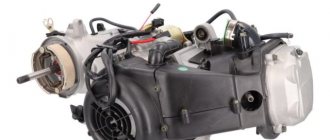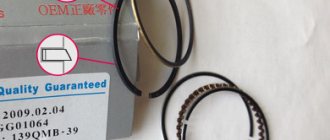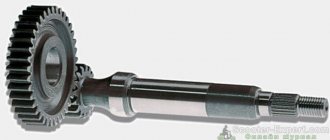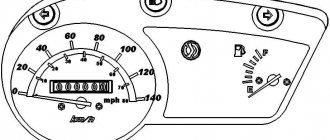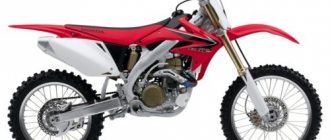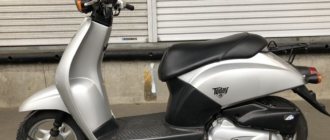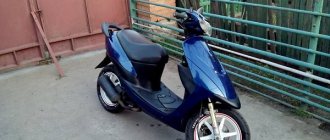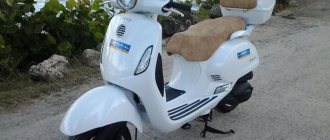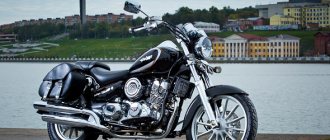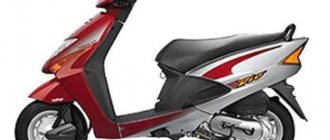The 157QMJ 150cc engine is a fairly common type of engine, which is now installed on Chinese scooters and is a copy of the Japanese Honda GY6 engine. The characteristics and service life of this 4t engine allow it to be subjected to tuning.
In this article, we present to your attention the tuning of the GY6 engine using the example of the YIBEN YB150T-15 scooter, namely an increase in piston volume from 150 cc to 170 cc. It is worth noting that the modernization of the scooter was carried out in Australia, which introduces adjustments to the prices of spare parts for tuning. The so-called collective farm is minimized here, tuning can be called bourgeois and scooterists who want to save money will not be suitable.
The marketing name of the prototype scooter in Australia is Ozooma 150 Maxx, released in 2007, however, this is not important, since these engines are installed on many models of Chinese cubic scooters, for example Viper Storm 150. The moped owner does not need to upgrade to a more powerful scooter model with 250cc engine. The purpose of upgrading the motor from 150cc to 170cc is to add a little top speed to the scooter, up to about 100 km/h without spinning. An untuned Yiben 150 scooter can travel approximately 80 km/h over a long distance without the risk of causing damage to the power unit. Another goal was to complete this entire upgrade without removing the engine from the scooter.
Scooter engine GY6 150 cm3 157QMJ - FULL SET.
Scooter engine GY6 150 cm3 157QMJ - FULL SET.
Equipment: Engine + CVT + Carburetor + Carburetor pipe + Switch + coil with high-voltage wire and spark plug tip + starter relay + turn relay + charging relay + Kickstator + The entire kickstarter mechanism + Electric starter.
- Payment
- Delivery
- Availability
1) For “Pickup” delivery, you pay in our store. 2) For “In Hand” delivery, payment for the goods is made upon receipt. 3) You can suggest how to pay and how to deliver the goods, we will consider your suggestions.
1) Pickup. You make a purchase in an online store, we put the product on reservation. And your purchase awaits you within 3 business days until you pick it up. 2) Hand delivery. We deliver the goods to you to the place you specify when purchasing. Delivery within the city is 500 tenge. 3) You can suggest how to pay and how to deliver the goods, we will consider your suggestions.
Check product availability by phone.
- Description
Description
Equipment: Engine + CVT + Carburetor + Carburetor pipe + Switch + coil with high-voltage wire and spark plug tip + starter relay + turn relay + charging relay + Kickstator + The entire kickstarter mechanism + Electric starter.
Direct deliveries from factories in China, the lowest price in the Republic of Kazakhstan, all spare parts are in stock.
157QMJ Engine Specifications Cooling System: Forced Air Bore: 149.6 Bore: 57.4 mm Stroke: 57.8 mm Maximum Power: 6.8 kW at 7500 rpm Maximum Torque: 9.8 Nm at 6000 rpm Idle speed: 1700 +/- 100 Engine starting: electric starter and kickstarter Transmission: Automatic integral transmission (CVT) Weight: 27 kg Power/weight ratio: 0.2
This engine can be considered Japanese. In the late 1990s, Honda Motor launched a new line of GY6 scooter engines, which replaced the units of the earlier Tact and Dio models. The new engine became a 4-stroke with a cylinder tilted forward (versus 2-stroke with an almost vertical, even slightly tilted cast-iron cylinder back). The number of valves is two, forced air cooling. Initially, two similar designs were developed: for 50 cm3 and 125 or 150 cm3. GY6 was installed on scooters of the (CH125/CH150) Elite and Spacey families.
Now this family of engines is installed on all scooters made in China, because this engine has proven itself to be the best: high performance, low consumption, easy to repair, all spare parts are available in our store and in any city of the Republic of Kazakhstan, low cost of the engine and spare parts, achieved through mass production around the world, ease of repair, reliability of design and components, high power output.
What kind of oil to pour into an ATV engine
ATV engine oil must first match the type of engine. The vast majority of existing models are equipped with one- or two-cylinder water-cooled gasoline engines, that is, they require API S oils. A small number of ATVs produced in the simplest configuration continue to use 2T engines - they are simpler, cheaper and lighter. In this case, only special two-stroke oils of API TC quality class can be used.
Heavy utilitarian ATVs, including those of the Side-by-side class, are also equipped with diesel engines. For them, it is worth choosing a specialized oil for diesel engines (API class group C), but it is also possible to fill with universal motor oils, since their characteristics are suitable for diesel engines used on utilitarian ATVs.
The frequency of oil changes is determined by the manufacturer and is given in the service book. It is recommended to change the oil at the beginning of the season if the ATV is not used in winter, even if it has only had low mileage in the previous year.
ATTENTION. Update your browser! Our site does not work correctly with IE 8 and older versions.
Local Ukrainian paragliders have approached me more than once. The reason is that I am engaged in high-quality Taiwanese tuning of scooter engines, which many are trying to adapt to their needs. Maybe there are experienced users on this forum who can correctly formulate the problem. which the engine must solve. I already understand that light weight is needed, but what else? In addition to tuning for Chinese, Taiwanese, Japanese engines with a volume of 50 to 250 cc, there is also a little more tuning for “Europeans”. Moreover, I cooperate with some engine manufacturers in Taiwan - I can find a 2T or 4T engine assembly. Puzzle - maybe I can help you. I have been helping scooter riders since 2010 and quite successfully. We respect the rules of the forum - we do not turn the forum into a “garbage dump” or a commercial platform.
p.s. Maybe in the end nothing will work out, scooters and paragliders are not the same thing. But it's worth a try
For starters: Here is a kit made from 125 cm3 - 233 cm3 Tuning kit GY6, 152QMI, 157QMJ
GY6 233cc
Based on the Chinese and Taiwanese engines, which are clones of the Honda GY6 of different quality, I can say that there are two options:
1. Engine crankcase of most models with dimensions between the engine studs of 54 mm: CPG 63 mm (180 cm3) + long-stroke crankshaft fits into such a crankcase
almost up to 200 cm3 + head with large or super-large intake/exhaust and corresponding “wide” camshaft or 4-valve with large intake/exhaust and corresponding “wide” camshaft
2. Engine crankcase with a distance between studs of 57 mm: CPG fits up to 67 mm + long-stroke crankshaft
up to 233 cm3 + head with large or super-large intake/exhaust and corresponding “wide” camshaft or 4-valve with large intake/exhaust and corresponding “wide” camshaft
According to two-stroke variants from the common ones: Engine from BVS 100 + piston 135 cm + crankshaft
There is no need to confuse real Taiwanese CPG with a fake. Unfortunately, such “good” is enough to sell the Chinamotoprom CPG as a Taiwanese one - this has become a favorite “business”
Many Taiwanese tuning manufacturers have only begun to promote their brands in the last couple of years, and previously worked as OEM/ODM partners of many European and American tuning brands. Modern European scooters often contain a majority of Taiwanese parts, including engines. In Taiwan there are 5 manufacturers of motorcycle equipment and they do everything well and with high quality, unlike China where there are hundreds of “manufacturers” and only a few do it well, and then under European or Japanese supervision. I was in Taiwan personally at the factories, I know what I’m talking about.
Sorry, yes *** let's say you need a Taiwanese tuning piston for which you need to remake half of the engine so that those 125 or more cubes do not bend the rest into the unit, if the scooter from its native Japanese produces 10 hp?
Here's a different approach. A green teapot comes to the store, for example, for a new CPG and the seller tells him that for his scooter there are 3 types of spare parts manufacturers, analogue (Japan, Italy, etc.), Taiwan and China! The pricing policy, I think, is clear to everyone. And here the buyer thinks that China is f***, the original is too expensive, and in the end the average is Taiwan. That’s the whole market. From here it emerges that the stingy pays twice, and the stupid pays three times.
And why fuss and throw away your hands if you can buy a budget version of the same Rocket or Archimedych for a PM installation?
I apologize again - this is my personal opinion and attitude towards second-rate products.
You probably started talking about 2T engines? If yes, sorry, I didn’t understand right away.
Small-scale equipment fell out of interest back in 2009 in Ukraine and almost completely stopped being imported to us, so we never even bothered with tuning for “fifty dollars” and 90 cc 2T Japanese-made ones. The only thing supplied for the 2T was a 135 cc CPG with a crankshaft for the Yamaha BVS.
Engine assembly 4T 157QMJ (GY6) 149.5 cm3 (12 wheelbase)
JavaScript is disabled in your browser
Despite all the variety and variety of Chinese scooters on Russian roads, their engines belong to only two categories. This is a two-stroke scooter engine and a four-stroke one.
These categories differ greatly in the number of models produced, so let's start with the largest category - the 139QMB four-stroke scooter engine. Its history began at the end of the last century, when in the 90s the Honda branch developed the first such scooter engine model, and today it is called KYMKO. Ten years later, China adopted this development and, together with Honda, began mass production. How good the final version turned out can be judged by the fact that scooter engines labeled 139QMB are regularly purchased from Japan and sold there under the Honda brand.
The 139QMB scooter engine has already become a legend in the motorcycle world, and Hongling Corporation, which officially produces it, installs this engine not only on motorcycles of its own brand, but also successfully sells them for assembly at prices of other motorcycle brands. The recognition of this scooter engine is simply colossal: the marking is located on the left side of the crankcase. The serial number begins with 139QMB, followed by the product number in the production batch.
The 139QMB scooter engine is practically flawless, it can be treated with some degree of carelessness or negligence (but, of course, in moderation). The warranty usually covers the first 5 thousand kilometers. This distance is necessary for the scooter engine to allow grinding in of all its units and components. Once the initial parameters are passed, the lifespan of which the 139QMB scooter engine is capable is about another 20 thousand kilometers. And this is at an average speed of 90 km/h. The engine power is more than enough for a full-size 2-seater scooter.
Some Chinese corporations decided not to look for easy ways and created their own unit. This scooter engine is marked 1P39QMB, and in terms of its external characteristics it is an exact copy of 139QMB. But if you look in more detail, the differences are clearly striking. The 1P39QMB scooter engine is assembled without adjusting the clearances in all valves. The same negligence can be seen in the carburetor, which requires mandatory adjustment and cleaning before starting. In the hands of an experienced scooter rider, the engine will, of course, work, but its main purpose is to make the scooter even less expensive. All budget options that are good for several trips are equipped with just such engines.
The engine of the scooter model 1P39QMB will not have proper dynamics if it has not been run in before use. Only after 2 thousand kilometers does it enter the optimal phase of operation, but after 10 thousand kilometers its performance drops sharply.
The 157QMJ scooter engine models can be produced in two volumes - 150 and 125 cc. see. They are installed on more expensive scooters “BM”, “Honling”, “Forsazh” and others. In terms of reliability and functionality, the 157QMJ scooter engine is an absolute copy of the 139QMB. Also, many design details in it are reminiscent of mass-produced Japanese analogues.
The service life of such engines is already an order of magnitude higher and amounts to 25 thousand kilometers. It has powerful acceleration coupled with very high speed. Their main drawback (if this can be considered a drawback) is their higher cost compared to the previous model. But having bought a 157QMJ scooter engine once, this purchase will serve faithfully for many years, without requiring major intervention in its operation.
There is only one two-stroke scooter engine made in China. Its model is D1E41QMB. It has a chain reverse gear, which fundamentally distinguishes it from all other representatives of this class of units. Reliable operation of such a scooter engine is achieved by adding oil to gasoline (proportion 40 to 1). The engine's lifespan is short - about 10 thousand kilometers, and subsequent repairs are required. It is necessary to replace the rings, which in terms of monetary investment will not be an expensive process. This scooter engine cannot handle speeds that exceed 50 km per hour.
Photo report: Repair of engine 157 QMJ of Atlant scooter (150 CC)
This article will show only the main stages of assembly and repair of the 157QMJ engine, which is very popular in Russia. If you describe the entire assembly process from start to finish, the article simply will not load in your browser. Therefore, for your convenience, at the end of the article and more, there are links that will lead you to where any stage of assembly and disassembly of a mechanism or assembly is of interest to you will be described in more detail.
It is worth noting that the 157QMJ engine is very simple in design, so to repair it there is no need to install additional pullers or devices. The engine that we will be assembling today was very worn out, so much so that there is nothing to talk about here. Whether you like it or not, you will have to change almost all the parts, from oil seals to the crankshaft. More details about disassembling this engine are written in the article: Disassembling the engine 157 QMJ of the Atlant scooter (150 SS)
So, first we clean off the remnants of old gaskets and sealant from the planes of the crankcase halves; if necessary, we “drive” the threads under the mounting bolts; by the way, we also do not forget to “drive” the threads on the bolts.
We blow through the oil channels with a compressor, thoroughly clean all parts from dirt and wash them.
Let's start assembling the engine as usual by installing new seals. Before installing the seals, it is advisable to heat the crankcase halves with a hair dryer and then press them into place using a mandrel. After pressing the oil seals, their edges must be lubricated with some kind of grease or engine oil. We will install a new crankshaft, since the old one “decided to live a long time.”
Take the crankshaft and insert it into the right half of the crankcase.
We turn the engine around, take the key of the overrunning clutch and insert it into the groove on the axle.
Lightly tap it with a hammer, making sure that it sits evenly in the groove without distortion.
We insert the oil pump drive axis into place.
We take the oil pump drive chain (in our case the chain is new), put it on the oil pump sprocket, then put it on the middle sprocket of the crankshaft, then put the pump sprocket on the drive axis.
Please note: the oil pump drive chain must be placed on the middle sprocket of the crankshaft.
We insert sprockets, a tin rod or a stick under the tooth and tighten the nut on the oil pump axis.
Screw the oil pump drive housing into place.
We take the overrunning clutch body, put it on the axle, turn the body so that the key on the axle fits into its groove on the body, then push the clutch all the way.
Insert the starter idler gear shaft
We put the starter intermediate gear on the axle
We put the overrunning clutch gear separator in its place.
We put the overrunning clutch gear on the axle
We put on the washer, thoroughly clean the threads of the trunnion and the nut, then degrease it, apply a “blue” locking agent to the threads (preferably) and using an old unnecessary screwdriver and hammer, tighten the nut (left-hand thread).
We take the second half of the crankcase, place some kind of block under it and insert the timing chain into it (the timing chain is also new).
We degrease the crankcase connector planes, insert the guide bushings (marked with arrows), and install a new gasket. For greater reliability, we apply sealant to the surface.
Lubricate the left crankshaft bearing with engine oil; it is best to apply oil to the bearing with a medical syringe. After everything has been done, carefully connect the crankcase mats.
Immediately tighten the bolts (marked with arrows).
In the same way, degrease the surfaces, insert the guide bushings (marked with arrows), install a new gasket and put on the cover.
We take the mounting bolts and insert them into place.
The bolts should be tightened crosswise, first tighten them lightly, then tighten them again but with greater force, and so gradually increasing the tightening force over several “circles”, tighten the bolts completely. Immediately after assembly (otherwise you will forget), pump engine oil into the bearing of the lower connecting rod head with a syringe. Just in case, apply sealant to the starter O-ring.
We install the starter in its place and tighten the bolts.
Engine device
Beginning scooter riders, if they need to repair the motor, try to understand its design. Diagram 157QMJ will help you obtain information about the structure of the power unit and its components. Having dealt with it, you can not only purchase the necessary spare parts for the 157 QMJ engine, but also correctly perform the work of assembling and disassembling the engine. Structurally, the motor is practically no different from its GY6 counterpart. The 157 QMJ has the same cylinder-piston group, clutch, crankcase, camshaft and muffler.
Y0121 Engine 157QMJ 150 cc
- Reviews
- How to buy
- Payment
- Delivery
How to buy
To purchase a product in our online store, select the product you like and add it to your cart. Next, go to the cart and click on “Place an order” or “Quick order”.
When placing a quick order, write your full name, phone number and e-mail. The manager will call you back and clarify the terms of the order. Based on the results of the conversation, you will receive confirmation of product registration by email or via SMS. Now all you have to do is wait for delivery and enjoy your new purchase.
Placing an order in standard mode looks like this: Fill out the form completely in successive stages: address, delivery method, payment method, personal information. We advise you to write information in the comments to your order that will help the courier find you. Click the "Place an order" button.
Cash payment
In case of self-pickup, payment for goods is made at the store cash desk. If the goods are delivered by courier, then payment is made in cash to the courier. When receiving the goods, be sure to check the contents of the goods, the presence of a purchase and sale agreement and a receipt.
Electronic payment methods
You can pay for your order using electronic payment methods - plastic cards and electronic money. Payment is credited within a few minutes from the moment the transaction is completed in payment systems.
Plastic cards
The personal information you provide (name, address, telephone, e-mail, credit card number) is confidential and will not be disclosed. Your credit card information is transmitted only in encrypted form and is not stored on our Web server.
The security of processing Internet payments using plastic cards is guaranteed by the acquiring bank. All card transactions occur in accordance with the requirements of VISA International, MasterCard and other payment systems. When transmitting information, special security technologies for online card payments are used; data processing is carried out on a secure high-tech processing server.
If you have questions about the confidentiality of transactions with payment cards and the information you provide, you can contact the bank's technical support service.
On the authorization page you will need to enter the card number, cardholder name, card expiration date, card verification number (CVV2 for VISA or CVC2 for MasterCard). All necessary data is printed on the card itself. The card verification number is three digits located on the back of the card. To pay, you will be redirected to the bank page. Payment must be made within 15 minutes after going to the card authorization page.
The transaction may take approximately 40 seconds. Wait for the operation to complete. Do not click the "Pay" button again. Payment occurs in real time and is credited within 15 minutes.
Non-cash transfer to a bank account
To pay by bank transfer, request an invoice from the manager. Funds are credited within 1-3 business days.
A refund
— in cash through the store’s cash register — using the payment terminal at the pick-up point in case of payment by card (a check will be required) — through the gateway of Sberbank PJSC in case of payment by card on the website — by bank transfer in case of payment by invoice
Around Moscow
Delivery of equipment in Moscow within the Moscow Ring Road - FREE!*
Delivery of equipment to the nearest Moscow region - 2000 rubles + 35 rubles/km from the Moscow Ring Road. The equipment is delivered assembled or in packaging at your request. You can pay upon receipt to the driver in cash or at the store cash desk. It is also possible to transfer to a Sberbank card or pay by invoice and through electronic wallets.
To the regions
Sending is carried out through Transport Companies: PEK and SDEK to the TK terminal in your region. Free delivery of equipment only in original packaging. It is possible to send assembled equipment by prior agreement. By prior agreement, we can send the goods to other shipping companies at your request. You can pick up the cargo using your passport at the TK terminal or order delivery to your home from the TK (the client pays).
Spare parts, consumables, and accessories are delivered according to TK tariffs. EQUIPMENT - delivered free of charge within the Russian Federation*
* — excl. the Far East region, as well as regions where delivery exceeds 5000 rubles. Free delivery does not apply to equipment that is on sale or at a discount.
To CIS countries
It is possible to send equipment and spare parts to the CIS countries. For more detailed information please call. Payment is made in rubles.
Delivery of equipment
The equipment is sent with a 10% advance payment*.
You can make an advance payment on your Account, through Sberbank Online, through the payment gateway of SBERBANK PJSC, through the store’s cash desk, or through electronic wallets. The rest is paid upon delivery of the goods at the warehouse of the Transport Company!
Delivery time depends on the availability of equipment in the warehouse and the remoteness of your region.
Viewed products
- Who are we
- Vacancies
- Contact details
- Payment
- Delivery
- Low price guarantee
- Availability and prices
- Credit
- Installment plan
- Returns and exchanges
- Promotions and discounts
- Commission
- Feedback
- Visit of the master
- Tuning
- Motor vehicle assembly
- ATV repair
- Motorcycle repair
- Scooter repair
- Maintenance
- Moto tire service
- Motor tow truck
- Storage
Error
Login to your personal account
Any questions?
Product added to cart
Terms of free delivery
Products from categories:
Motor vehicles Tracks Yoke Radiator removal Doors Rear carrier Underbody protection Fender protection Buckets Overhang reduction kit Roofs UTV Trunk guard Snow blades Front carrier Footboards Trailers for ATV Sleds and accessories Tires -> ATV, UTV Tires -> Road, sports Tires - > Cross Tires -> Scooters, mopeds Tires -> Enduro Original spare parts for Japanese and European brands (as agreed) Commission and used goods (as agreed)
Delivery period.
— If the product is in stock, the order is delivered within 1-2 business days from confirmation of the order and receipt of payment. The guaranteed delivery time is 5 working days from confirmation of the order and receipt of payment. — If one or more products in the order are out of stock, our manager will contact you and inform you of the order completion date. — Orders are delivered on the following days:
Monday from 11.00 to 19.00 Tuesday from 11.00 to 19.00 Wednesday from 11.00 to 19.00 Thursday from 11.00 to 19.00 Friday from 11.00 to 19.00
Other delivery days and times are discussed individually.
Delivery by transport company
1. TC ZhelDorExpedition https://www.jde.ru/ 2. TC Business Lines https://www.dellin.ru/ 3. TC SDEK https://www.edostavka.ru/ 4. TC KIT https:/ /tk-kit.ru/ 5. TK Energy https://nrg-tk.ru/
Delivery by default is carried out to the TK terminal in your city. You can find out the address and operating hours of the TK terminal in your city by going to the transport company’s website.
The order can be received by the person in whose name the order was placed upon presentation of a passport of a citizen of the Russian Federation.
To select a delivery city, start entering its name in the “Location” field, and then select the desired option from the proposed list
If there is no TC branch in your city, you will not be able to select it. In this case, use the Postal delivery method.
The delivery cost calculation is approximate; the exact cost is determined when sending the order.
Payment of delivery costs occurs upon receipt of the order.
Delivery period.
You can calculate the order delivery deadline yourself by using the calculator on the website of the shopping center you need, or contact our managers. It is worth considering:
— The indicated delivery time is approximate.
— If the product is in stock, the order is dispatched within 1-2 business days from the moment the order is confirmed and payment is received. The guaranteed dispatch time is 5 working days from the date of confirmation of the order and payment for the order.
— If one or more products in the order are out of stock, our manager will contact you and inform you of the order completion date.
— Orders are dispatched on the following days:
Monday from 11.00 to 19.00 Tuesday from 11.00 to 19.00 Wednesday from 11.00 to 19.00 Thursday from 11.00 to 19.00 Friday from 11.00 to 19.00
Terms of delivery of orders by Russian Post
Delivery is possible to populated areas of the Russian Federation. Delivery to other countries is not available.
Please provide correct information when placing your order.
After sending your order, we will send you a parcel number by email to track its movement.
When receiving your order, you must have your passport with you.
Cost of delivery
The exact delivery cost is determined when the order is submitted.
The cost of delivery depends on parameters such as: destination, weight, and dimensions of the box with the order, as well as some other parameters.
All orders are sent by us from Samara.
Delivery of any order in Samara from our store to the Russian Post branch is free.
The cost of order transportation within Russia is paid by the Buyer upon receipt of the order by mail.
Cost of delivery
We will be happy to deliver your order free of charge by Russian Post!
Delivery of some goods is paid regardless of the order amount.
Products from categories:
Motorcycles Tracks Yoke Radiator removal Doors Rear carrier Underbody protection Fender protection Buckets Overhang reduction kit Roofs UTV Trunk guard Snow blades Front carrier Footboards Trailers for ATV Sleds and accessories Tires -> ATV, UTV Tires -> Road, sports Tires -> Cross Tires - > Scooters, mopeds Tires -> Enduro Original spare parts for Japanese and European brands (as agreed) Commission and used goods (as agreed)
Delivery period
We will be happy to deliver your order free of charge by Russian Post!
The delivery time for your order depends on your location. The average delivery time in Russia is 5-7 days. It is worth considering:
Technical characteristics and design of ZIL 157
Serial production of this car began in the late 40s of the last century. The technical characteristics of the ZIL-157 allowed this technology to be in demand for half a century. The cars were discontinued only in 1994.
Application of the ZIL-157 car
The initial purpose of the ZIL-157 is to meet the needs of the defense industry. The vehicle carried ammunition, various cargo and soldiers. Additional equipment with a winch made this type of transport convenient for evacuation of tracked and wheeled vehicles.
Over time, modifying the truck, the designers adapted it into the national economy:
- in construction;
- in various industries;
- in agriculture;
- in logging;
- on fish farms;
- in hunting grounds.
The ZIL-157 truck was actively in demand abroad. In Finland, this technique is still used in logging.
Thanks to its successful design, the car was successfully operated in all weather conditions. Adjusting the tire pressure made it possible to move at optimal speed on any soil - on arable land and off-road, in swampy areas and on sand dunes, as well as snow drifts.
Specifications
ZIL-157 has been popular for so long due to its technical parameters, the main ones of which are shown in the table.
Technical characteristics of the first models
| Characteristics | Unit change | Options |
| Max. declared speed | km/h | 65 |
| Load capacity on highway/dirt road | T | 4,5/2,5 |
| Fuel tank volume | l | 150 |
| Swivel outer radius | m | 12 |
| Max. lifting angle with load | hail | 28 |
| Ford depth | m | 0,65 |
In the first models, a worm steering mechanism with a 5-speed gearbox was used for control. In more modern cars, the steering wheel is equipped with a hydraulic booster. The transfer case is 2-speed and has a front axle clutch. The rear axles are parallel-separate.
In improved models, each bridge was supplemented with a reinforced casing. The front suspension is a set of polyelliptic springs with hydrotelescoping shock absorbers, the rear suspension is a balancing type of springs.
The main braking system is a drum-type, pneumatic-driven type on all wheels. The parking brake is also a drum type, but has a mechanical drive to the transmission.
Description of the car engine
The first engines for the ZIL-157 were created taking into account the elimination of the shortcomings of the engines installed on the predecessor (ZIS-151). The improvements included such parameters as engine power, degree of overheating, trouble-free operation, gasoline consumption, etc. The modernization of the engine lasted until 1978.
The main type of engine of this car is carburetor, running on gasoline. But several models were released with a diesel engine, and it did not live up to expectations. The main disadvantage is the high level of vibration and shaking, leading to discomfort for the driver and passengers.
Engine Specifications
Type of gasoline engine – 4-stroke. The block consists of 6 cylinders arranged in a row. Made of cast iron, and the cylinder head is made of aluminum. The block has a closed “jacket”. The coolant circulates through the block circuit.
Engine characteristics:
| Characteristics | Unit change | Options |
| Volume (before/after modernization) | l | 5,38/5,559 |
| Power at 2600 rpm (before/after) | l. With. | 104/110 |
| Torque | H/m | 334 |
| Cylinder/piston diameter | mm | 101,6/100 |
| Piston stroke | mm | 114,3 |
| Average fuel consumption | l/100 m | 42 |
| Filling tank volume | l | 150 |
The table shows the parameters of the base car.
Thanks to improvements in subsequent models of the crankshaft, oil pump, pump seals, and the introduction of closed crankcase ventilation, many characteristics of the ZIL-157 engine were improved. In the latest models, it has become possible to install an additional tank with a capacity of 65 liters. This makes it possible to cover a distance of more than 500 km on one gas station.
Despite the simplicity of the design and unpretentiousness, the engine is trouble-free and reliable in operation. Even after inactivity, it starts quickly, but is sensitive to low temperatures, so in winter it requires special care.
Over time, the thermostat on the engine was modified, but the cars continued to be equipped with insulating covers until the last moment. The modifications also eliminated problems with motor overheating.
Cabin structure
The original cabin of the ZIL-157 was uncomfortable for both the 2 passengers and the driver. Over time, thanks to telescopic shock absorbers, the designers made the steering easier, and the driver began to exert less physical effort when driving. By introducing an additional radiator with a fan-impeller, it became possible to heat the cabin and the front window.
Equipping the interior with a dashboard made it possible to control the car’s systems: axle gears, turning off headlights, lubrication and brake pneumatic pressure gauges, foot start, winch levers, etc.
Modifications of the ZIL-157 truck
During the entire time that ZIL-157 rolled out of the container at the Likhachev plant, the cars were constantly modernized. Basic models are characterized by the presence of a tire pressure system, single-pitch tires, split wheels, foot-operated starter, and a winch mounted on extended brackets.
The main stages of truck modernization are shown in the table.
Modifications of ZIL-157:
| Letter index | Peculiarities |
| B | Not equipped with a tire pressure control system |
| IN | Used as tractors |
| G | Equipped with electrical sealed, shielded electrical equipment. The cathode terminal of the battery was connected to the car body |
| TO | Second generation of base cars with a more powerful engine (109 hp). It has a synchronized gearbox and another rear view mirror. These models began to use winches on extended brackets |
| KG | The second basic option is supplemented with electrical sealed equipment with a screen |
| KD | Representative of the 3rd generation, supplemented by an electric starter and a new on-board platform. Has improved motor characteristics and increased load capacity |
| E | The ZIL-157 car was produced exclusively for export to countries located in mid-latitudes |
| YU | Export version for tropical conditions. It is lightweight due to the absence of an engine pre-heater and interior heating |
In addition to the basic models, other options were used: special vehicles for the army, workshops on wheels, vehicles for electrical supply, fire trucks.
